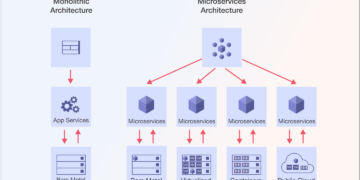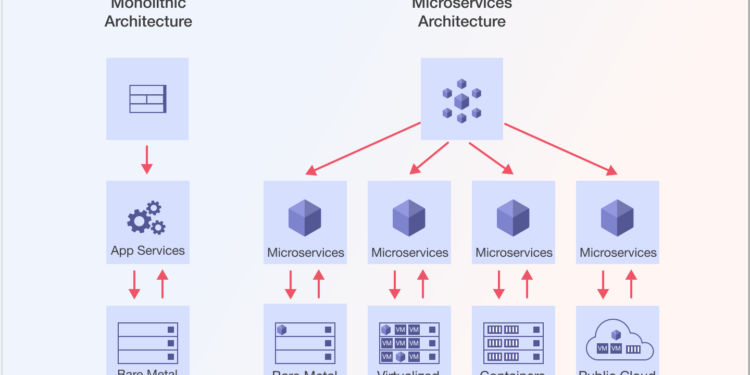Microservices architecture has taken the tech world by storm. It’s the cutting-edge system that many organizations are adopting to improve their software development processes. But what exactly is [microservices architecture]? How does it work, and why is it so popular today? This article will summarize it, explaining the key components, benefits, challenges, and more.
What is Microservices Architecture?
In a nutshell, [microservices architecture] is a design style for building applications where a system is broken down into small, independent services that work together. Each service, or “microservice,” performs a specific function. These microservices communicate with each other using APIs (Application Programming Interfaces) and can be developed, deployed, and maintained separately.
Key Features of Microservices Architecture:
- Decentralization: Every microservice is autonomous and focuses on a single business function.
- Independence: Each microservice can be deployed independently without affecting the others.
- Flexibility: Microservices can be developed using different programming languages, databases, or tools.
How is Microservices Architecture Different from Monolithic Architecture?
Before the rise of microservices, many applications were built using monolithic architecture. In a monolithic system, all software components are tightly interconnected and operate as a single unit. While this approach works for small applications, it can become a nightmare as systems grow more complex.
Differences Between Microservices and Monolithic Architectures
FeatureMicroservices ArchitectureMonolithic Architecture
Size Small, independent services Single, large application
Scalability Highly scalable Limited scalability
Flexibility Technology-agnostic Single tech stack
Deployment Independent deployments Requires full redeployment
Failure Isolation Service failures are isolated One failure affects the entire system
Development Speed Faster, parallel development Slower, as teams work on the same codebase
As you can see, microservices provide a more flexible, scalable, and reliable way of building and maintaining complex applications.
Why Choose Microservices Architecture?
Why should businesses move to [microservices architecture]? Let’s look at why companies like Netflix, Amazon, and Google favor this design.
- Scalability
Microservices allow organizations to scale individual services instead of the entire application, making scaling more efficient and cost-effective. For example, suppose your application has a search service that needs to handle more traffic than other services. In that case, you can scale only the search microservice without increasing the resources of different services.
- Flexibility in Development
One of the standout features of [microservices architecture] is the ability to use different programming languages, databases, and frameworks for each service. This provides immense flexibility to developers and allows them to choose the best tools for the job. For instance, one service can use Java, while another might use Python.
- Faster Time to Market
Because each microservice is independent, teams can develop and deploy features more quickly. This means businesses can release updates or new products faster, giving them a competitive edge in the market.
- Improved Fault Isolation
A single error can cause the entire application to crash in monolithic systems. However, in a [microservices architecture], if one microservice fails, it doesn’t necessarily bring down the whole system. This improves the reliability and robustness of the application.
- Easier Maintenance and Updates
Since each microservice has a specific responsibility, fixing bugs or making updates becomes more straightforward. You can update or patch one microservice without worrying about breaking the entire system.
- Better Team Collaboration
In large organizations, development teams often face challenges working on the same codebase. With [microservices architecture], teams can work independently on different services, improving collaboration and productivity.
How Microservices Communicate
Microservices rely on communication to work together and deliver the application’s complete functionality. This communication is typically achieved through APIs or messaging systems.
Types of Communication in Microservices:
- Synchronous Communication: Microservices communicate in real-time using APIs like HTTP/REST.
- Asynchronous Communication: Services communicate via message brokers (e.g., Kafka, RabbitMQ), where messages are queued and processed later.
API Gateways: The Gateway to Efficiency
An API Gateway is an essential component in [microservices architecture]. It acts as an entry point for all client requests, routing them to the appropriate microservice. API gateways can also handle authentication, load balancing, and rate-limiting tasks.
The Challenges of Microservices Architecture
While [microservices architecture] offers numerous benefits, it’s challenging. Understanding these obstacles can help organizations better prepare for a successful implementation.
- Increased Complexity
Breaking an application into smaller services means there are more moving parts. Managing communication between services, maintaining data consistency, and handling failures can become complicated.
- Deployment Overhead
Although microservices allow for independent deployment, coordinating these deployments can require more effort than in a monolithic system. It would help to have the right tools and processes to handle frequent implementations effectively.
- Data Management
In monolithic applications, data is often centralized in one database. However, in [microservices architecture], each microservice may have its database. This leads to challenges with data consistency, and implementing cross-service transactions can be tricky.
- Latency and Performance
Because microservices communicate over the network, latency issues are possible in systems that require real-time responses. Network reliability and bandwidth become critical concerns.
- Testing and Debugging
Testing microservices can be more complex compared to monolithic systems. Integration testing, in particular, becomes more challenging because you need to ensure that all microservices work together correctly.
Best Practices for Implementing Microservices Architecture
Implementing [microservices architecture] effectively requires careful planning and execution. Below are some best practices to ensure success.
- Start Small
Instead of converting an entire monolithic application into microservices, begin with a small, self-contained part of your system. This approach lets teams get comfortable with the new architecture before fully committing.
- Use DevOps and CI/CD
Microservices thrive in environments supporting continuous integration and delivery (CI/CD). Automation tools can help manage deployments, scaling, and updates, making the process smoother and more reliable.
- Monitor Everything
Since microservices operate independently, monitoring each service for performance, errors, and network issues is essential. Tools like Prometheus, Grafana, and ELK stack are popular for monitoring microservices architecture.
- Implement Circuit Breakers
Use circuit breakers in your microservices to prevent cascading failures. Circuit breakers act as safeguards by detecting when a service is failing and automatically rerouting traffic or stopping communication until the issue is resolved.
- Emphasize Security
With microservices, you often expose multiple APIs to external clients, creating security risks. Implement authentication, authorization, and encryption to ensure your services remain secure.
When to Avoid Microservices Architecture
While [microservices architecture] offers numerous advantages, some projects have better solutions. Some situations might call for sticking with a monolithic architecture.
- Small Teams or Projects: If your application is small and your team needs more resources to manage the complexity of microservices, a monolithic approach may be more practical.
- Short-term Projects: For quick projects where time-to-market is more important than scalability, microservices might add unnecessary complexity.
- Lack of Expertise: Implementing [microservices architecture] requires specialized knowledge in distributed systems, network communication, and containerization. If your team lacks this expertise, the transition could be difficult.
Real-world Examples of Microservices Architecture
To better understand [microservices architecture], let’s look at how some leading companies use it to power their systems.
- Netflix
Netflix uses microservices to handle its enormous user base. The platform comprises hundreds of microservices that manage everything from recommendations to streaming. Each microservice is designed to be fault-tolerant, ensuring that even if one part of the system fails, users still experience minimal disruptions.
- Amazon
Amazon has moved from a monolithic architecture to microservices over the years. This shift allows them to handle millions of daily transactions, ensuring their systems are scalable, reliable, and fast.
- Spotify
Spotify uses [microservices architecture] to power its music streaming services. Different microservices manage features such as music recommendations, user playlists, and payment systems, enabling Spotify to rapidly scale and improve its features.
The Future of Microservices Architecture
The future of [microservices architecture] is bright. As more organizations move toward digital transformation, microservices will continue to play a crucial role in building agile, scalable, and reliable systems. The rise of cloud computing, containers (like Docker), and orchestration tools (like Kubernetes) have made deploying microservices easier than ever. With AI, automation, and edge computing advancements, microservices will likely become the standard architecture for building complex applications in the coming years.
Conclusion
[microservices architecture] offers a modern, flexible, scalable solution for developing complex applications. It enables businesses to build resilient systems, release updates quickly, and scale effortlessly. While there are challenges, organizations can leverage microservices to significantly improve their software development processes with careful planning and the right tools.































